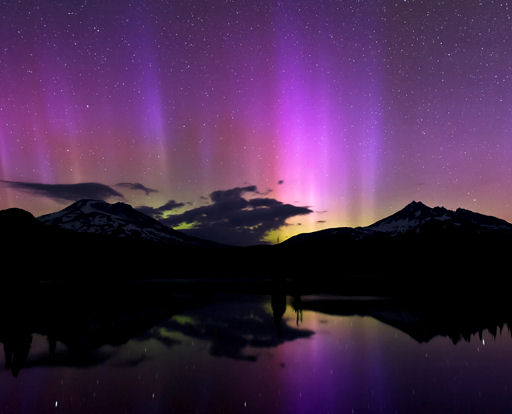Listen to radar echoes from satellites and meteors, live on listener-supported Space Weather Radio. | | | AURORA ALERT: A geomagnetic storm is in progress as Earth's magnetic field continues to reverberate from a CME strike on July 14th. Sky watchers in Scandinavia, Canada, Alaska and northern-tier US states from Maine to Washington should be alert for auroras after nightfall. Observing tip: The hours around local midnight are usually best for aurora-spotting. Aurora alerts: text, voice. When the CME first arrived on July 14th, its effect appeared weak. However, conditions in the wake of the CME have since become stormy. On July 14-15 Northern Lights appeared in the United States as far south as California, Colorado, Missouri, Utah, Wisconsin, Iowa, Minnesota, Washington, Illinois, Kansas, Nebraska, Michigan and Arkansas. Brad Goldpaint sends this picture of the auroras reflecting from Sparks Lake in central Oregon: 
Meanwhile in the southern hemisphere, the aurora australis has been sighted in New Zealand, Australia, and directly above the South Pole itself. Visit our aurora gallery for a complete set of images: Realtime Aurora Photo Gallery
Realtime Space Weather Photo Gallery Potentially Hazardous Asteroids ( PHAs) are space rocks larger than approximately 100m that can come closer to Earth than 0.05 AU. None of the known PHAs is on a collision course with our planet, although astronomers are finding new ones all the time. On July 15, 2012 there were potentially hazardous asteroids. Recent & Upcoming Earth-asteroid encounters: | Asteroid | Date(UT) | Miss Distance | Mag. | Size | | 2003 KU2 | Jul 15 | 40.2 LD | -- | 1.3 km | | 2004 EW9 | Jul 16 | 46.8 LD | -- | 2.1 km | | 2002 AM31 | Jul 22 | 13.7 LD | -- | 1.0 km | | 37655 Illapa | Aug 12 | 37 LD | -- | 1.2 km | | 2000 ET70 | Aug 21 | 58.5 LD | -- | 1.1 km | | 1998 TU3 | Aug 25 | 49.2 LD | -- | 4.9 km | | 2009 AV | Aug 26 | 62.8 LD | -- | 1.1 km | | 1998 UO1 | Oct 4 | 60.1 LD | -- | 2.1 km | | 2005 GQ21 | Oct 12 | 77 LD | -- | 1.0 km | Notes: LD means "Lunar Distance." 1 LD = 384,401 km, the distance between Earth and the Moon. 1 LD also equals 0.00256 AU. MAG is the visual magnitude of the asteroid on the date of closest approach. | | The official U.S. government space weather bureau | | | The first place to look for information about sundogs, pillars, rainbows and related phenomena. | | | Researchers call it a "Hubble for the sun." SDO is the most advanced solar observatory ever. | | | 3D views of the sun from NASA's Solar and Terrestrial Relations Observatory | | | Realtime and archival images of the Sun from SOHO. | | | from the NOAA Space Environment Center | | | the underlying science of space weather | | 
